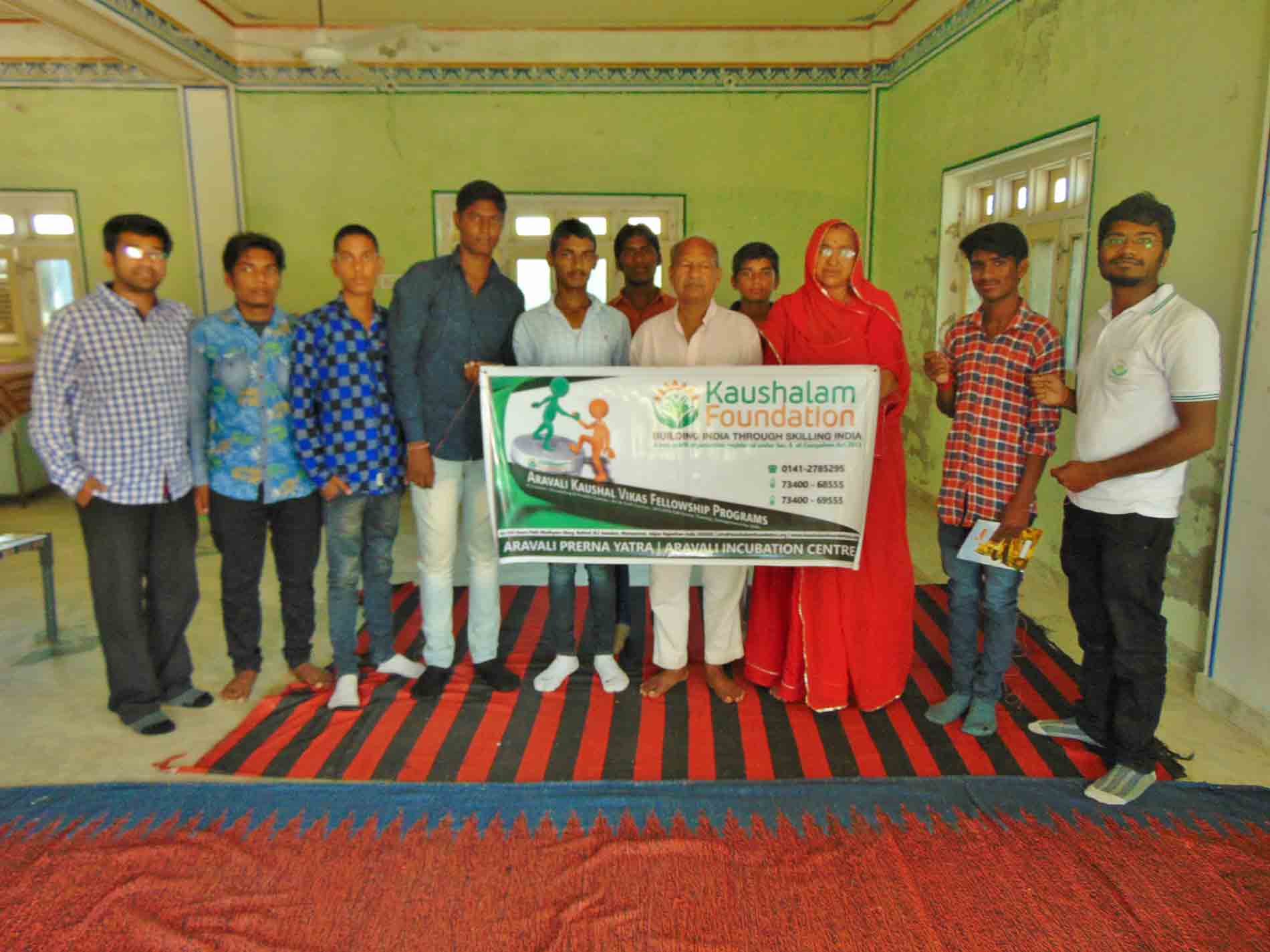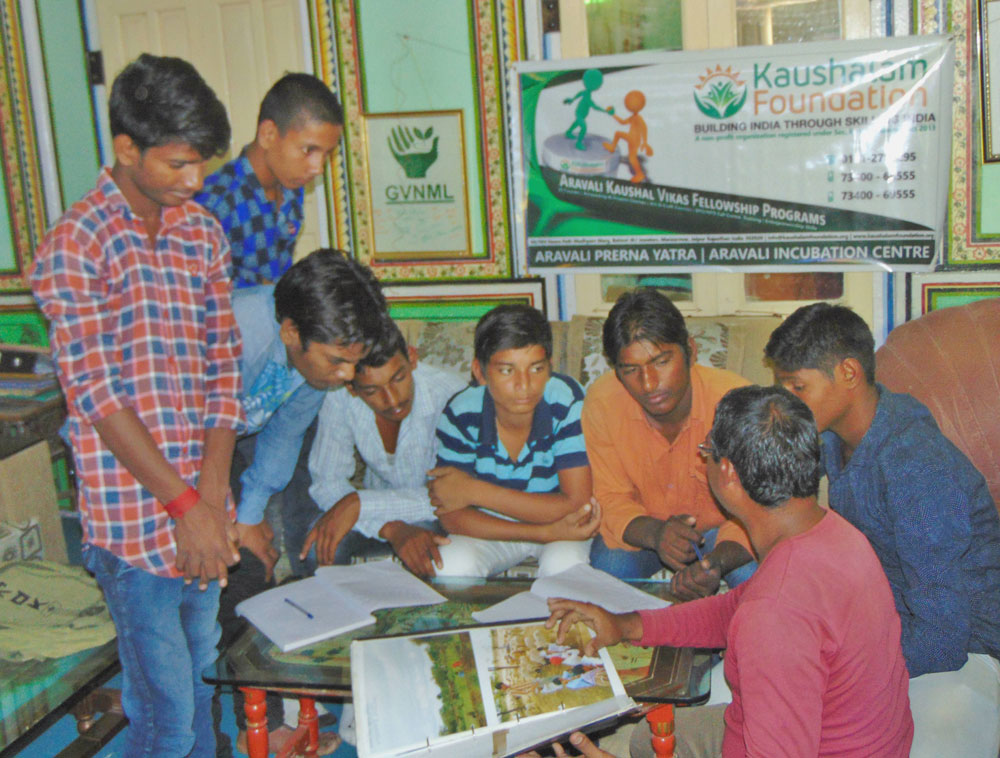Kaushalam Foundation’s Gramodhyami Initiative- Organized exposure visit for trainees

Kaushalam Foundation organized exposure visit for village level entrepreneurs as part of capacity building programme.
Kaushalam foundation, as part of its Gramodhyami Initiative (Village Level Entrepreneurship Development Program), organized a one day exposure visit for its trainees from Skill Development Centre, Bhapura village, Jaipur on 25th Oct. The objective of the visit was to create awareness about pioneering grassroots social enterprises and to awaken the entrepreneurial spirit in them. Participants visited the following organizations;
- GVNML, Laporiya village, Dudu Block, Jaipur, Rajasthan
- Barefoot college, Tiloniya village, Ajmer, Rajasthan
Laporiya, a village situated at a distance of around 80 km from Jaipur is known for its unique techniques for conserving rain water, protecting environment and maintaining eco-balance. Lakshman Singh, an environmentalist from Laporiya village, is working on ground since 1977 for the development of the village. His work and team got consolidated in 1986 under the banner of GVNML, (Gram Vikas Navyuvak Mandal, Laporiya) a voluntary organization registered under Rajasthan Society Registration Act 28, 1958.
The visiting group was welcomed by Sangram Singh from GVNML. After a brief introduction about GVNML’s work in last 30 years, the group was taken to the field location to show them how water and environment conservation efforts by the villagers helped their village to mitigate the climate change and save itself from natural disasters. Active community participation in environment governance is the key for successful implementation of Natural Resource Management in Laporiya village.
Trainees were excited to see water ponds and greenery all around which is not a usual sight in their village. Sangram Ji started with a brief introduction about Lakshman Singh Ji, issues Laporiya faced earlier and establishment of GVNML, followed by the best practices they adopted in agriculture, environment and water conservation.
Laxman Singh with Trainees
Excerpts from his dialogue:
Once upon a time – The Gloomy Laporiya
Laporiya receives an annual rainfall of about 323 mm which is much lower compared to the Rajasthan state avg. rainfall 440mm. Before GVNML’s intervention in reviving the livelihoods through water and nature conservation efforts, the village suffered from acute water scarcity resulting in a number of miseries. The inhabitants were malnourished, hunger and absolute poverty in the village, diseases and illness were untreated, children remained illiterate and cattle died of thirst. Pasture lands were encroached by influential section of the society. All these resulted in migration of villagers in search of livelihoods. They used to travel as far away as Agra, 300 miles, grazing animals along the way.
GVNML’s approach to sustainable livelihoods
Sangram Singh Ji explains, “GVNML’s mantra for sustainable development is ‘Cooperation, peace and participation’. We emphasise on following factors for achieving the 360 degree model of growth:”
- Dairy farming is one of the major livelihoods in rural areas. In order to get maximum output from cattle rearing we brought GIR specie cows from Gujarat to breed with our cows. The results are amazing. The cows now give 10-15 liter milk daily as compared to 3 liter before.
- Rain water harvesting through Chauka system has proved to be a blessing for village. The system consists of square shaped embankments. On three sides there are nine inch walls and one side is left open to allow rainwater to fill the structure. As one structure fills, then the overflow fills the next Chauka and so on. Retaining the rainwater in this way helps prevent soil erosion and recharges the surface water enabling various grasses to thrive. This has the effect of holding the soil together and, as the Chauka system is used mostly on common land, provides grazing areas for cow and goat herds. For this to be effective it is combined with the planting of grass, seeds and trees.
- Common Pasture Lands of 150 Beegha (242805 sq. meters) have been developed on both sides of village which is used in a social contract in order to stop migration of shepherds from village.
- Water storage and conservation by shramdaan through developing three ponds namely Ann Sagar (Grain pond), Fool Sagar (Pond for supplying water to flora and fauna) and Dev sagar (Pond for religious purposes).
- Environmental Protection and eco balance by developing separate area for birds and rats. There are very strict laws in Laporiya regarding hunting of animals and birds. Defaulters are punished sharply.
- Promotion of Organic Farming and formation of seed bank, cleaning of traditional wells, involving all to evolve the feeling of self-belongingness and annual celebrations to show gratitude to God Indra are some of the best practices adopted by GVNML for Laporiya village.
Laxman Singh Ji’s intervention in livelihoods and GVNML
Laxman Singh was 18 years old when he realized that the root cause of all the sorrows of Laporiya is due to water scarcity and the only solution to this problem is to repair the broken Talab (pond) of village. Repairing a pond of 1.5 km long and 15 ft. wide remained as a herculean task as there was no financial aid available from either the Government or from any other funding agency.
But as they say where there is will there’s Way, Laxman Ji himself took up this task and went to the pond with spade and hoe. A close friend Mr. Ramavtar also joined. They used to ask for sand from every household and started repairing the devastated pond wall by pouring 100 man (4000kg) sand daily. On the 7th day, more youth from village joined them, which later became the foundation stone for GVNML. With their combined efforts the pond finally got repaired. Seasonal rains 2 months later, filled the pond with enormous water, thus catering to the needs of inhabitants. The pond was later named as Ann Sagar (Grain pond). This incident dates back to 1977. Later, Laxman ji with combined efforts of villagers was able to introduce innovative techniques of rainwater harvesting, environment conservation and organic farming.
One can now witness the holistic development in Laporiya village with the efforts of GVNML.
Trainees actively participated by asking questions and providing feedback through reflection forms as well as in person. Acc. to one of the trainees Anoop, “Interactions with Lakshman Singh ji and learnings from Laporiya village are unforgettable moments for us. We never knew such type of village existed in our state of Rajasthan. My biggest take away from this visit is that active community participation is very vital in village development. I’m keen on replicating some of the best practices followed in this village in my village Bhapura”.




